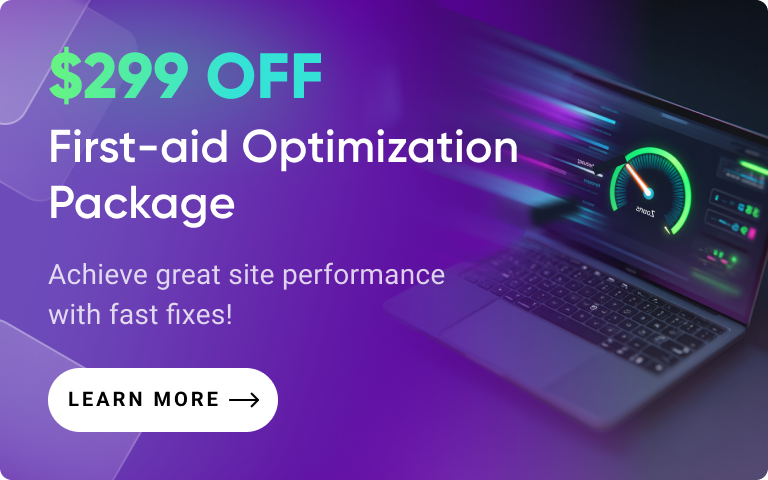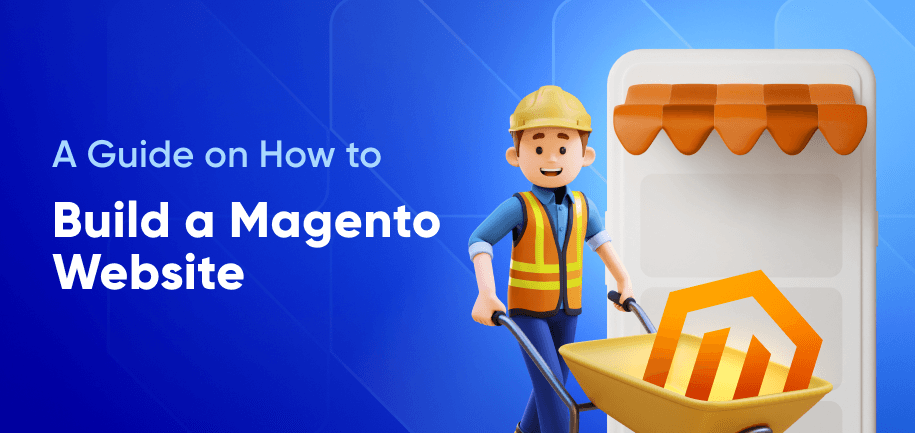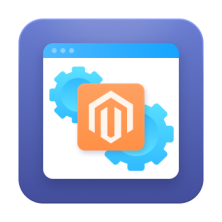Among the many e-commerce platforms, Magento powers over 656,000 online stores worldwide. This makes it one of the most popular solutions for digital retail. However, despite the platform’s popularity, Magento owners often face challenges such as complex installation, customization difficulties, and resource-intensive maintenance.
In this article, we'll guide you on how to create a Magento website from scratch and share best practices used by Amasty’s Magento development services team, skilled in building successful e-commerce solutions with Magento.
What is Magento?
Magento is an e-commerce platform that offers a comprehensive suite of tools to create and manage online stores. Known for its flexibility, Magento empowers businesses to tailor their websites to meet the unique needs of their target market.
Magento comes in two main editions: Magento Open Source (formerly known as Community Edition), which is free and highly customizable, and Magento Commerce (formerly Enterprise Edition and also known as Adobe Commerce now), which offers additional features and support for large-scale businesses.
Read More: Key Magento Facts and Statistics
Planning Magento Website Development
The first step in any successful Magento website development is planning. Proper planning ensures you're building a website that aligns with your business goals and appeals to your target audience. Here are the most important considerations:
1. Identify Your Target Audience and Market
Before you start, you should understand your audience and market. Identify who your potential customers are, along with their demographics, interests, and buying behaviors. Market research helps establish customer personas and tailors your website's design and functionality to effectively meet their needs.
2. Set Clear Goals for the Online Store
Set specific, measurable goals for your Magento store. Determine whether your focus is on increasing sales, building brand awareness, or expanding into new markets. Clear objectives guide the development process and help measure success.
3. Consider the Costs
With Magento, you need to tackle various costs, such as hosting, domain registration, theme customization, and extension purchases. Depending on the size and complexity of your project, you can expect to spend anywhere from a few thousand to tens of thousands of dollars.
4. Choose a Fitting Server
Choose the right hosting environment, which is a critical component of your Magento site's performance and security. Ensure that you have a reliable server with ample resources to handle traffic and transactions seamlessly. Verify that your hosting provider supports PHP, MySQL, and either Apache or Nginx web servers.
Read More: Best Magento Hosting Providers
5. Select a Memorable Domain Name
Your domain name is a key part of your brand identity. Choose a name that is easy to remember, reflects your business, and is SEO-friendly. A good domain name will enhance your website's searchability and trustworthiness.
How to Install Magento: A Quick Overview
Once your planning is complete, the next step is to install Magento on your server. Our tech team has already shared a full and detailed guide to Magento Installation, so below is just a summary of the necessary steps:
- Prepare Server Environment: Ensure you have the necessary server requirements for Magento.
- Download Magento: Obtain the latest version from the Magento Marketplace.
- Upload Package: Transfer the downloaded package to your server using FTP or SSH.
- Set File Permissions: Adjust the permissions as per Magento documentation.
- Create Database: Set up a new database and user for Magento, with full privileges.
- Start Installation Wizard: Access the Magento setup wizard by navigating to your website’s URL.
- Configure Database: Enter the details of the database you created earlier.
- Customize Web Configuration: Set the base URL for your store and choose other configurations.
- Set up Cache: Consider the tips from our Magento cache guide to optimize performance.
- Complete Installation: Finalize your setup by following the instructions in the wizard.
- Set Up CDN: Enhance site speed by setting up a Content Delivery Network (CDN)
- Configure Store Locale, Currency, and Language: Navigate to the admin panel to set your store’s default locale, currency, and language settings for targeted regions.
While the installation process might seem challenging, you can straightforward it with professional guidance or hands-on assistance.
Selecting a Theme for a Magento Shop: Key Must-Haves
When selecting a Magento theme for your online store, prioritize key features that enhance user experience. Here's what to consider:
- Responsiveness: A responsive theme adjusts its layout for all devices, which is important for your store's usability and will minimize bounce rates in a mobile-first world.
- Accessibility: Themes supporting web accessibility ensure all users, including those with disabilities, can navigate your site, expanding your audience and ensuring compliance with standards like ADA and WCAG.
- Customization Options: Essential for brand consistency, themes should allow easy adjustments to layouts, colors, and fonts without complex coding.
- Performance Optimization: Choose a theme that boosts loading times, which is key for both user experience and SEO performance.
- SEO-Friendliness: Themes with built-in SEO features and clean, semantic code enhance search engine visibility and site performance.
- Support and Updates: Access to reliable support and regular updates will help to maintain your store’s security and functionality over time.
If you’re looking for a modern, versatile Magento theme, Hyvä is an excellent choice. Here are the main 3 reasons:
- Hyvä is designed with performance in mind. It minimizes the use of JavaScript, resulting in faster loading times and a smoother customer experience.
- Hyvä offers extensive customization capabilities. You can easily modify layouts and styles to align with your existing brand guidelines, ensuring consistency across all customer touchpoints.
- With a focus on simplicity and efficiency, Hyvä improves the user experience with an intuitive design that minimizes distractions and maximizes conversion potential.
The right Magento theme is key to a successful Magento e-commerce platform. With a custom-developed Hyvä theme, you harness a store that’s not only powerful and adaptable but also built to cater to the evolving needs of modern digital commerce.
Choosing and Installing Magento 2 Extensions
Magento is a robust e-commerce platform with customizable and scalable features, but you’ll often need more than its default capabilities. Here’s why extensions can simplify your Magento website development process:
- Enhanced Functionality: Extensions allow you to add specific features without extensive custom development.
- Improved User Experience: Extensions can optimize the shopping experience, improve navigation, enhance site speed, and add personalization features, leading to higher conversion rates.
- Seamless Integrations: Many extensions offer seamless third-party integrations with payment gateways, shipping services, and marketing tools, streamlining operations and reducing manual efforts.
- SEO and Marketing: Certain extensions help improve on-page SEO, automate marketing tasks, and engage customers more effectively, boosting traffic and sales.
- Security Enhancements: Security-focused extensions add additional layers of protection to safeguard customer data and ensure a secure shopping environment.
Recommended Magento 2 Extensions
The Magento 2 extension market is vast, and installing them is quick and easy. Here are some must-have extensions to enhance your Magento store.
1. Improved Layered Navigation
Customers enjoy a better shopping experience with this tool, which allows the filtering of products based on attributes like price, brand, color, and size. The result is a quicker, more efficient browsing experience that helps customers find what they want, boosting conversion.
This extension streamlines the checkout process by consolidating multiple steps into a single, user-friendly page. Features like automatic address suggestions, multiple payment method support, and real-time order summary updates contribute to a faster, more convenient checkout process, ultimately increasing conversion rates.
3. Elasticsearch for Magento 2
This extension optimizes your store’s search functionality by enhancing speed, accuracy, and relevance. It improves product discovery by refining search queries, enabling better filtering, and offering advanced analytics, ultimately delivering a more seamless and efficient shopping experience for your customers.
Read More: 20+ Best Magento Extensions
Payment Gateways for Magento
The checkout experience your customers have is directly influenced by how you integrate payment gateways. As of version 2.4.7, Magento offers several payment gateways by default, including:
- PayPal: Supports PayPal services like Express Checkout and PayPal Payflow Pro.
- Braintree: A PayPal service providing credit card payments, PayPal, Venmo, and local payment methods.
- Klarna: Allows customers to "buy now, pay later" with instant credit.
- Amazon Pay: Enables customers to use their Amazon accounts for payment.
- Authorize.net: Offers a dependable credit card payment option.
Built-in payment methods are easy to integrate directly through the admin panel. To configure these:
- Navigate to Admin Panel > Stores > Configuration.
- Under Sales, click Payment Methods.
- Select the payment gateway you wish to configure (e.g., PayPal, Braintree, Klarna, Amazon Pay, or Authorize.net).
- Enable the gateway and configure its settings (API keys, merchant account details, and payment preferences).
- Save the configuration to activate the gateway on your store’s checkout.
In addition, some of the best third-party payment gateways are made compatible with Magento via installable extensions, such as:
- Stripe: Known for its robust API and ability to handle multiple payment methods globally.
- Worldline: Offers extensive global coverage and a suite of merchant services.
- Square: Ideal for businesses requiring both online and offline payment capabilities.
- Adyen: Offers a unified commerce platform with support for multiple payment methods worldwide.
- Skrill: Provides global reach with support for over 30 currencies.
While more payment gateways offer greater flexibility, they can also complicate and increase the risks in managing payments. To address these challenges, you might explore solutions such as Payment Restrictions for Magento 2, which allow for conditional control over payment methods.
Configuring Shipping in Magento
To ensure smooth order fulfillment, you need to choose reliable shipping carriers and offer a variety of delivery options. Let’s review your key steps.
Shipping Methods and Carriers
Magento store settings allow you to integrate with major carriers and configure shipping methods that suit your business model and customer expectations.
- Select Reliable Carriers – Choose shipping providers like UPS, FedEx, DHL, and USPS based on their coverage, delivery speed, and cost-effectiveness in your target regions.
- Configure Carrier Integration – Set up carrier accounts in your Magento admin panel and enable real-time shipping rates, tracking, and automated label generation.
- Offer Multiple Shipping Methods – Provide options like standard, express, overnight, and same-day delivery to accommodate different customer needs.
- Enable Store Pickup or Local Delivery – If applicable, allow customers to pick up orders at a physical location or opt for same-day local delivery.
Shipping Rates and Rules
Defining clear and competitive shipping rates is important for customer satisfaction and cost management. Magento lets you customize shipping fees based on various conditions to balance affordability and profitability.
- Set Dynamic Shipping Rates – Define rates based on weight, dimensions, destination, and delivery speed to ensure accurate pricing.
- Offer Free Shipping Incentives – Encourage larger orders by setting free shipping thresholds, such as "Free shipping on orders over $50." (You’ll need to set up a Free Shipping Bar in this case)
- Implement Flat-Rate or Tiered Pricing – Simplify pricing with a flat rate per order, per item, or shipping zone while providing affordable options for customers.
- Create Region-Based Rules – Adjust shipping costs based on customer location, product category, or cart value to optimize costs and profitability.
- Enable Real-Time Rate Calculation – Integrate with carriers to display live shipping rates at checkout, ensuring customers receive the most accurate costs.
Since configuring shipping in Magento may seem complicated, you might want to explore Shipping Suite for Magento 2. This suite streamlines the process and offers advanced features that simplify shipping configuration, allowing you to:
- Create custom shipping methods and rates tailored to your business model.
- Implement flexible shipping rules to optimize costs and customer satisfaction.
- Integrate seamlessly with more carriers, enhancing your shipping operations.
Managing Magento Products
Managing products in Magento involves several key tasks, from the organization of them into categories to the management of inventory levels. Here's a detailed guide on each aspect:
Creating Product Categories
You should organize your products into logical categories to enhance both user navigation and SEO. Here are some best practices for setting up product categories:
- Define a Clear Hierarchy: Start with broad categories and subdivide them into more specific subcategories. For example, a top-level category might be "Clothing," with subcategories like "Men's Clothing," "Women's Clothing," etc.
- Use Descriptive Names: Ensure that category names are intuitive and descriptive for easier navigation.
- Limit Subcategory Depth: Aim for a category structure that is not overly deep, ideally three levels or fewer to avoid confusing navigation.
- Consider Customer Experience: Organize categories based on how customers naturally think about products, which may involve using analytics to understand browsing behavior.
Adding Products
Adding products to your Magento catalog is a fundamental task. Follow these steps to ensure your products are well-represented:
- Navigate to the Product Section: In the Magento admin panel, go to the "Catalog" section and select "Products."
- Add New Product: Click on "Add Product" to start the process.
- Enter Product Details: Fill in the essential information, such as Product Name, SKU, and Description.
- Define Product Attributes: Assign attributes like color, size, and brand to enhance product searches and filtering.
- Enable Shop by Brand: If your store supports Magento Shop by Brand, ensure products are categorized under their respective brands to improve navigation and brand-focused shopping.
- Set Pricing: Enter the product price and adjust any applicable discounts or special pricing offers.
- Upload Images: Add high-quality product images to provide customers with a clear view of the product.
- Configure Product Variations: For products with multiple variations, such as different sizes or colors, configure each option under "Product Variations."
- Create a Product Page: For smaller catalogs or popular items in larger ones consider creating dedicated product pages that convince the buyer to purchase.
Inventory Management
Efficient inventory management ensures you keep track of stock levels and manage demand effectively. Follow these steps and best practices:
- Track Stock Levels: Regularly update stock counts and monitor them to maintain optimal levels.
- Set Up Stock Alerts: Configure alerts for low stock levels to replenish inventory on time.
- Manage Backorders: Decide whether to allow backorders and configure settings to manage them appropriately.
- Handle Out-of-Stock Items: Use Magento's tools to either hide out-of-stock products or maintain visibility with a message indicating availability.
Read More: Managing Inventory in Magento 2
Magento Testing and Quality Assurance
Before you unveil your Magento store and present it to the public, you should conduct rigorous testing across several domains:
- Functional Testing – Ensure all store functionalities, from browsing to checkout, work seamlessly as intended.
- Performance Testing – Assess site speed and load times. This optimization enhances user satisfaction.
- Security Testing – Guarantee the site's security by identifying vulnerabilities and implementing fixes. Secure your site with SSL certificates and other protective measures.
Testing is an important aspect of launching your Magento store, but with our professional services, it becomes much simpler. Amasty can assist with each QA type, including speed optimization and code audits.
Before You Go Live
Before launching your website, ensure all elements are optimized and functional. Here's a concise checklist to guide you:
- SEO Optimization – Ensure meta titles, descriptions, and URLs are properly structured for search visibility. Generate and submit a sitemap for indexing.
- Design & UX Review – Verify that themes, banners, and navigation align with your brand and provide a seamless user experience across devices.
- Functionality Testing – Conduct end-to-end tests on checkout flows, payment gateways, and account creation to eliminate friction points.
- Security & Compliance – Install an SSL certificate, configure firewalls, enable two-factor authentication (2FA), and set up regular backups.
- Performance Optimization – Run a speed audit, optimize images, enable caching, and test load times to ensure fast and responsive pages.
Post Magento Launch Activities
Launching a Magento store is a big achievement, but it is just the start of your journey toward e-commerce success. After the launch, it's important to pay attention to regular monitoring, maintenance, marketing, and SEO to keep your store competitive and profitable.
Continuous Monitoring and Maintenance
Your Magento store should be adapted to different changes. Regular monitoring, support, and maintenance are important to keep your site secure, performing well, and offering an excellent user experience.
- Ensure your store's protection by regularly updating it against threats. Frequent checks will help you stop problems before they impact your business.
- Keep your site well-maintained to ensure it loads quickly, reducing bounce rates and satisfying your customers. Regular checks will help you find and fix any issue.
- Research user behavior, so that you can make improvements that enhance the shopping experience, attracting more customer visits and boosting sales.
Strategic Marketing and SEO Enhancement
To maximize the reach and impact of your Magento store, robust marketing and a solid SEO strategy are essential. With the right tools, you can improve visibility, drive traffic, and convert visitors into loyal customers.
- SEO – A well-optimized site ranks higher and attracts more organic traffic. On-page SEO elements, such as meta tags and keywords, boost visibility. Rely on solutions like SEO Toolkit that simplify SEO management with meta templates, rich snippets, and automated optimization, ensuring your store always stays competitive.
- Targeted Marketing – Tailored promotions drive higher conversion rates by offering the right deals to the right customers. Tools like Special Promotions Pro helps you create advanced discount rules, like "Buy X, Get Y," tiered discounts, and exclusive offers for VIP customers, making your campaigns more strategic and effective.
- Content Strategy – Engaging, well-structured content keeps visitors interested and strengthens brand credibility. Consider using extensions similar to ChatGPT AI Content automates content creation for product descriptions, blog posts, and SEO copy, ensuring consistent, high-quality messaging while saving time and effort.
Building a Magento Website: Key Insights
Magento offers a strong foundation for e-commerce success with its flexible customization, built-in SEO tools, and seamless payment integration. To get the most out of your store, follow our expert tips from above and rely on robust extensions for improving performance, navigation, and conversions.
Looking for tailored Magento store enhancements? Explore our Magento development services to refine your store and better meet your business goals.
Frequently asked questions
Yes, Magento is a robust e-commerce platform designed to help businesses easily build and manage online stores, which offer extensive features and customization options suitable for various business sizes.
To create a Magento e-commerce website, select a compatible host, install Magento, and choose a theme that aligns with your brand. Add products, configure payment and shipping options, and test the site thoroughly before launch.
Magento has two editions: Magento Open Source, which is free but requires separate hosting and additional costs, and Magento Commerce, a paid version with advanced features and dedicated support.
Yes, Magento is still widely used and powers a significant number of online stores worldwide, thanks to its flexibility, scalability, and continuous updates.
Magento and Shopify both enable e-commerce but differ significantly. Magento offers extensive customization and requires technical expertise, while Shopify is user-friendly with quick setup, suitable for less technical users.



























